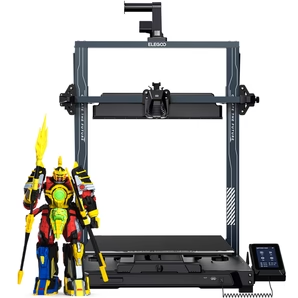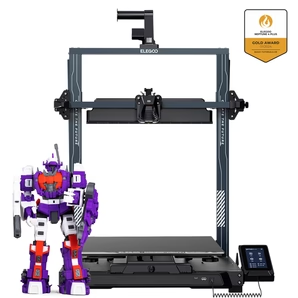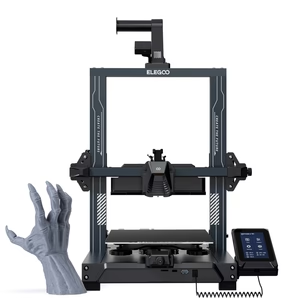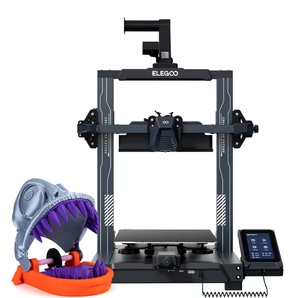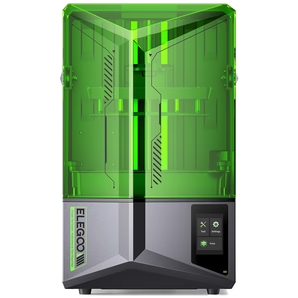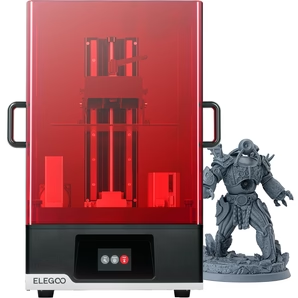Getting Started with Resin 3D Printers for Beginners
If you're a 3D printer beginner and you’re unsure of what model to buy, then we have options and some ideas to help you make the correct decision.
Alternatively, perhaps you just bought a beginner resin 3D printer and are ready to start exploring the world of resin printing. If so - then we’d recommend you hit our “3D Printing Projects” resource.
In any event, if you’re new to the world of 3D Printing, we’ve got you!

This article, aimed at beginners, delves deeply into the intricacies of resin 3D printing.
We'll clear up any confusion concerning resin 3D printers, the printing process, resin kinds, and how to get started.
You can consider this resource as a guideline to help you decide why you should buy a resin beginner 3D printer.
Resin printing for beginners can be a challenge, so we hope that this guide helps you to avoid common 3D printing pitfalls, and accelerate your resin printing game!
Article Outline:
- Resin 3D Printing For Beginners: An Overview
- Why Choose Resin Over Filament 3D Printing?
- The Different Types Of Resin Printers
- 10 Reasons We Recommend That You Choose Resin Over Filament 3D Printing?
- What Do You Need to Get Started?
- As A Beginner, What Type of Resin Should You Use?
- How to Use a Resin 3D Printer for the First Time?
- 5 Reasons Why Elegoo Printers Are An Ideal 3D Resin Printer For Beginners
- 10 Steps To Achieve the Perfect Resin 3D Print?
- How to Troubleshoot Common 3D Resin Printing Problems
Resin 3D Printing For Beginners: An Overview
Resin 3D printing is a form of additive manufacturing that uses a photosensitive liquid resin and a UV light source to construct high-resolution 3D models layer by layer.
This printing technique produces detailed prints, making it a favorite choice for professionals and hobbyists alike.
It's an ideal solution for printing 3d game miniatures, jewelry, dental models, and other intricate designs that require precision.
Why Choose Resin Over Filament 3D Printing?
Understanding how resin 3D printers work can significantly ease the printing process for beginners.

The decision between resin and filament 3D printing is influenced by aspects such as material qualities, detail requirements, print speed, and cost.
Here are some of the advantages of resin 3D printing versus filament 3D printing.:
Advantages of Resin 3D Printing
- Higher Resolution and Detail: Resin printers have higher resolution and detail than most filament printers. This is due to their ability to manufacture thinner layers and have a sharper laser or projector point.
- Smooth Surface Finish: Objects printed with resin typically have a smoother surface directly out of the printer, requiring less post-processing.
- Material Properties: Some specialist resins have unique material qualities like as translucency, flexibility, or better temperature resistance that are not always available or feasible in filament form.
- Better for Complex Geometries: Resin printing is frequently more suited for complicated designs that require very defined detail and intricacy, such as jewelry or dental models.
- Stable Mechanical Properties: Resin-printed parts can have more consistent mechanical properties compared to FDM parts, which are more prone to anisotropy (different mechanical properties depending on the direction of the print layers).
- Consistency: Resin printers often produce more consistent results across multiple prints of the same object.
A resin 3D printer operates using a process known as vat polymerization.
The printer's LCD screen projects UV light that selectively hardens the liquid resin in a vat layer by layer to form the 3D model.
After each layer hardens, the build plate lifts slightly to allow the next layer of resin to be cured.
The Different Types of Resin Printers
The below data contains information on the different types of Resin printers.
| 3D Printing Technology | Fused Deposition Modeling (FDM) | Stereolithography (SLA) | Selective Laser Sintering (SLS) | Digital Light Processing (DLP) |
| Material | Thermoplastic filament | Liquid resin | Powdered material | Liquid resin |
| Print Quality | Lower quality with visible layer lines | High-quality prints with smooth surfaces | Strong and durable parts | High-resolution prints without visible layer lines |
| Accuracy | Medium accuracy, depending on printer and settings | High accuracy and detail | High accuracy and detail | High accuracy and detail |
| Speed | Fast printing speed for larger parts | Moderate printing speed for detailed parts | Slower printing speed due to the resin powder-fusing process | Fast printing speed for small detailed parts |
| Cost | Inexpensive compared to other technologies | Expensive resin materials | Expensive machines and powders | Expensive resin materials |
| Accessibility | Widely available, easy to use | Limited availability, requires special handling | Limited availability, requires special handling | Limited availability, requires special handling |
10 Reasons Why We Recommend Resin Over Filament 3D Printing
While FDM (Fused Deposition Modeling) 3D printers are standard, resin printers offer some distinct advantages.
They can print complex geometries with intricate details that FDM printers may struggle with. Additionally, resin 3D printers typically produce smoother surface finishes, reducing the need for post-processing.
Here are ten reasons why resin printing (for beginners) is a wise choice:
- Efficient with intricate and delicate designs
- Produces minimal visible layer lines
- Transparent and translucent prints
- Wide range of vibrant colors
- Faster curing process
- Less warping or shrinkage
- Easier maintenance and calibration
- Compatibility with biocompatible resins
- Smooth surface finish
- Rapid printing speed
What Do You Need to Get Started?
There are some basic equipment you must have before you venture into Resin 3D Printing. This includes the resin 3D printer itself, photosensitive resin, a resin vat, and a build plate.
You'll also need safety gear, like gloves and goggles to protect you from skin and eye irritation from uncured resin. When working with resin 3D printers, safety should always be your top priority.
To avoid accidental splashes from hurting your skin, always use gloves and protective glasses when handling resin.
Additionally, we recommend that you operate in a well-ventilated place because resin fumes can be dangerous.
After printing, make sure to thoroughly clean your print and workplace of any uncured resin.

Aside from a good printer and resin, and perhaps most importantly here's what you need: imagination!
Your creative ability is very vital in creating 3D prints.
Another necessity to help you get started is to learn how to create basic 3d shapes.
You can get enough insights on this from specific 3d printing youtube channels and certain 3d printing websites to help you on your printing journey.
As A Beginner, What Type of Resin Should You Use?
The type of resin to use depends on the type of Resin 3D Printer as different resin 3D printers use different types of resins.
Your choice of resin also depends on what you want to print. Standard resin is ideal for general printing, while flexible resin suits prints that need some elasticity.
Importantly, always ensure you check the printer's manufacturer's recommendations when choosing resin.
How to Use a Resin 3D Printer for the First Time?
Starting your resin printing journey may feel daunting at first, but it doesn't have to be.
Here are x4 Simple Steps we'd recommend that will help you get going:
- Stay organized: have a clean printer and workspace
- Pour the resin into the vat
- Start printing your 3D model! (Here's inspiration on what to print)
- Ensure to monitor the printing process closely, especially the first few layers, as this is critical for successful printing.
x5 (Legit) Reasons Why Elegoo Printers Are An Ideal 3D Resin Printer For Beginners
There's a wide variety of resin 3D printing models in the market.
For beginners, we recommend the Elegoo Mars series for the following reasons:
- It's Affordable!
- Value for money is one of the hallmarks of ELEGOO printers. This makes them an excellent choice for beginners and printers on a budget.
- User-Friendly
- Ease of use and setup is another excellent attribute of ELEGOO printers. They have intuitive controls and user-friendly interfaces.
- Reliable Performance
- With sturdy build quality and durable components, the ELEGOO printers consistently deliver reliable printing results. Thus, it is a reliable choice for beginners to use.
- Versatility
- 3D printing with ELEGOO printers accommodates different applications and skill levels, for various printing needs and supports a wide range of materials.
- Supportive Community...ELEGOO has an active user community that provides resources, tutorials, and troubleshooting help, which can be valuable when you need assistance or inspiration.
x10 Steps To Achieve the Perfect Resin 3D Print
Achieving the perfect resin 3D print requires patience, practice, and fine-tuning of your printer’s settings.

You also need to ensure your 3D model is properly supported during the printing process to avoid a failed print.
In summary, here are 10 simplified and concise steps to achieve a perfect resin 3D print as a beginner:
- Choose a suitable resin 3D printer
- Understand the recommended settings for your resin
- Ensure the build plate is clean and level
- Slice your model properly, considering orientation and supports
- Generate adequate support for stability
- Check if your design requires additional considerations
- Clean the resin tank before each print
- Monitor the print for any issues
- Post-process and cure the print as instructed
- Learn from the experience and adjust settings based on outcomes
Troubleshoot Common 3D Resin Printing Problems?
Despite your best efforts, you may encounter some common issues like failed prints or warping. However, don't be discouraged.
These are common setbacks that are needed to fine-tune your printing prowess if you don’t relent.
So, you need to troubleshoot to find the cause of the setbacks.
Troubleshooting involves identifying the problem and making necessary adjustments, such as leveling the build plate, adjusting the exposure time, or cleaning the resin vat.
Closing Thoughts
In summary, getting started with resin 3D printing is an exciting endeavor. It opens up a world of possibilities for creating intricate and high-quality 3D prints.
To get the best out of your resin 3D printing experience, remember these key points:
- Understand how a resin 3D printer works.
- Choose the right type of resin for your print.
- Properly prepare your printer and workspace.
- Monitor your print, especially the first few layers.
- Always prioritize safety when working with resin.
- Don’t be afraid to troubleshoot and fine-tune your printer’s settings.
With these points in mind, you're ready to dive into the world of 3D printing and unleash your creativity.
Happy printing!



















